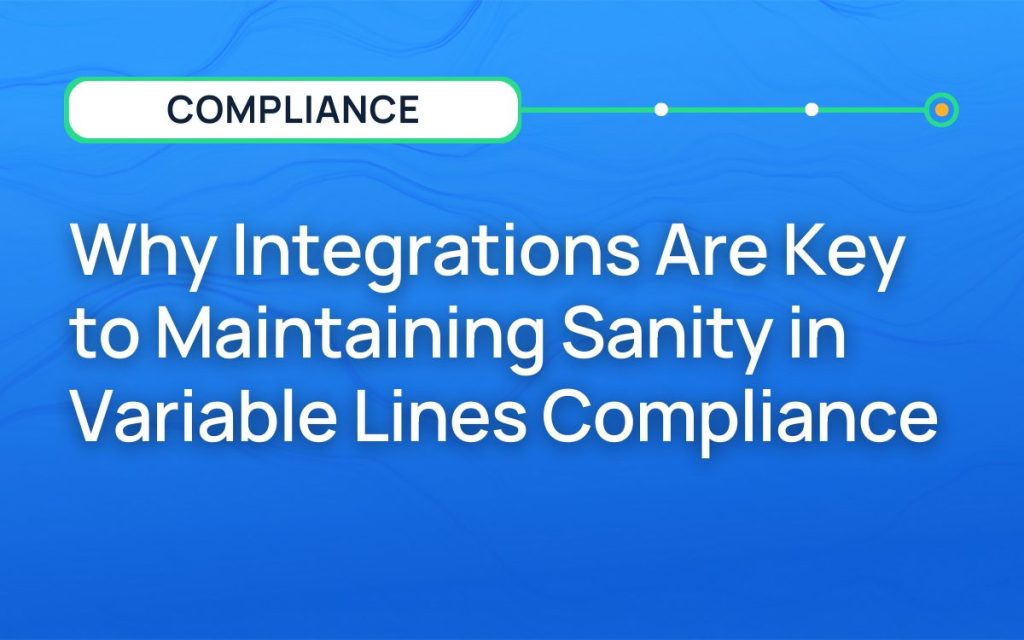Why Integrations Are Key to Maintaining Sanity in Variable Lines Compliance

Integrating compliance solutions into the rest of your technology is the biggest time saver (and risk-reducer!) for compliance teams and their variable lines brokers.
Retirement-focused insurance products have driven a rise in dually licensed financial professionals. These pros hold both insurance licenses and have passed Financial Industry Regulatory Authority (FINRA) Series exams. Many professionals acquire dual licensure to address federal and state concerns about funds amassed in Employee Retirement Income Security Act (ERISA) accounts. Yet, that move comes with what may feel like a more-than-doubled compliance responsibility.
For financial professionals like variable lines brokers or insurance-licensed financial advisers, maintaining compliance traditionally takes a huge amount of time for administrative tasks. Meanwhile, increased regulatory scrutiny over products like annuities demands these professionals spend more time with clients and prospects. With this kind of time squeeze, what’s a person to do?
It’s not just individual brokers, producers, and advisers who are in this position. Carriers, MGAs/MGUs, and agencies that take on compliance responsibilities for their contracted partners must tackle both sides of the proverbial house.
The unique challenges of variable lines brokers and dually licensed advisers
Thanks to regulatory developments from the last decade, financial professionals dealing with retirement funds – ERISA funds like 401(k)s and IRAs – have to handle regulations from their state department of insurance and the Department of Labor (DOL). If that professional is dually licensed, they also have to follow rules of the Securities and Exchange Commission (SEC).
General carrier duties of best interest annuity compliance
Under some of these rules, carriers that sell products like annuities – anything that might be funded by ERISA assets like 401(k)s – have duties beyond basic license and appointment compliance. Of course, they need to ensure a broker has the appropriate insurance licenses and has the correct exams to sell their products. But they may also have to track data like:
- whether a broker gave their clients the correct disclosures,
- whether the broker historically has a high policy replacement rate (and is potentially churning or twisting contracts), or
- whether a broker or adviser’s total sales are heavily weighted in one single product.
State insurance compliance
State laws and department of insurance (DOI) regulations require carriers to only accept business from and pay commissions to licensed producers in good standing. That means carriers should know their brokers’ insurance license status at all times, or, at a minimum, every time they accept new business or cut a commission check. This isn’t easy with brokers who may be selling products across the country and who may have more than 50 insurance licenses to maintain at any given point.
Basic securities compliance
Like insurance license compliance requirements, securities compliance mandates that carriers and agencies benefiting from variable lines sales must verify their brokers have passed the correct Series exam and are registered to a securities firm.
In sum, carriers have to examine both sides of a broker’s licensure, as well as fulfill more holistic requirements like anti-fraud, background checks, and annuities scrutiny.
Variable lines brokers and the struggle to maintain compliance
Variable lines products are notoriously difficult to understand and sell correctly. It’s understandable that they come with an extra level of scrutiny.
To fulfill this extra level of scrutiny, brokers have to spend more time with clients to make adequate disclosures, or, if using ERISA funds, do a thorough analysis of a client’s financial situation. But maintaining the administrative work of compliance will also require a broker’s time and attention.
When each business submission requires 12 pages of data, that’s 12 pages of risk to a broker, 12 pages they can forget or mangle.
Why do broker duties matter to carriers?
When brokers are squeezed for time and their livelihoods depend on how much business they can submit in a day, they have very real incentives to cut corners.
If your brokers have to complete manual paperwork and repetitive data entry as part of your compliance process, that’s not just inconvenient. It’s a systemic risk.
Operationalizing a lower risk variable lines broker compliance process
How can carriers, MGAs, MGUs, and agencies avoid the systemic risk that pits variable lines sales against compliance?
Automated, integrated compliance is the answer. How? With AgentSync Manage.
Let’s unpack.
Insurance compliance is a difficult beast because of the abundance of state requirements your organization and insurance brokers or producers may have to meet. Seeing data directly from a source of truth is mission critical. If you aren’t validating your broker’s self-reported data against the National Insurance Producer Registry (NIPR), then you may very well be working with faulty (risky) data.
AgentSync Manage draws NIPR’s rich, comprehensive data into a Scorecard view so you can see at a glance where the trouble spots are regarding your producer or broker licenses and appointments.
Variable lines compliance adds complexity because of the FINRA component. AgentSync Manage with enhanced variable lines support gives you a unified view of both insurance and securities data for your brokers. Don’t guess whether your brokers gave you the right CRD – know with accurate data drawn from the securities industry’s source of truth.
Unhassle your variable lines brokers
Compliance is a hassle for people up and down the distribution chain precisely because it involves re-inputting the same data across multiple systems, double-checking, triple-checking, and then still finding errors later in the process. By validating broker data against both industries’ sources of truth, you can skip the part where you enter and re-enter inaccurate data, and avoid having to return to your brokers time and time again for repetitive information, forgotten documentation, or updated data.
Use integrations to simplify your annuity compliance
Your holistic policy outlook is stored in one place. Your commission data lives in a payment system. And your license and appointment compliance data is housed in spreadsheets or possibly a bespoke legacy compliance system. If these systems don’t talk to each other, then every compliance check, every commission payment, is a matter of struggling across data silos.
AgentSync Manage users often have their license and appointment data drawn across systems via data integrations that give them fullstack visibility. With integrations, your software could automatically validate that your commission is being paid to someone with the proper licenses and appointments, stopping violations before they happen. Policy admin systems with license and appointment integrations can red-flag someone with a history of spotty compliance, giving you the data to protect your organization before something happens, and providing an audit trail in case of a review from a state department of insurance.
AgentSync Manage: Solving for compliance before it’s a problem
You can simplify compliance for both internal and external stakeholders by using AgentSync Manage with enhanced variable lines support to get visibility into your brokerforce. Stop waiting for the time crunch to catch up with your team, and use AgentSync Manage to end compliance violations before they happen. To see how AgentSync Manage can help you with your variable lines brokers, request a demo today.

